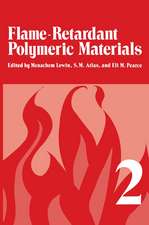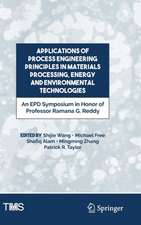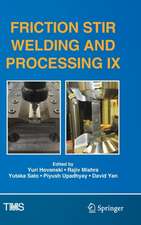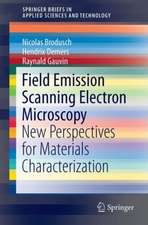Flame - Retardant Polymeric Materials: Volume 3
Autor Menachem Lewin, S. M. Atlas, Eli M. Pearceen Limba Engleză Paperback – 5 iul 2012
Preț: 647.40 lei
Preț vechi: 761.65 lei
-15% Nou
Puncte Express: 971
Preț estimativ în valută:
123.90€ • 127.99$ • 103.11£
123.90€ • 127.99$ • 103.11£
Carte tipărită la comandă
Livrare economică 26 martie-09 aprilie
Preluare comenzi: 021 569.72.76
Specificații
ISBN-13: 9781475701142
ISBN-10: 1475701144
Pagini: 252
Ilustrații: X, 238 p.
Dimensiuni: 210 x 297 x 13 mm
Greutate: 0.61 kg
Ediția:Softcover reprint of the original 1st ed. 1982
Editura: Springer Us
Colecția Springer
Locul publicării:New York, NY, United States
ISBN-10: 1475701144
Pagini: 252
Ilustrații: X, 238 p.
Dimensiuni: 210 x 297 x 13 mm
Greutate: 0.61 kg
Ediția:Softcover reprint of the original 1st ed. 1982
Editura: Springer Us
Colecția Springer
Locul publicării:New York, NY, United States
Public țintă
ResearchCuprins
1 The Flame Retardation of Polyolefins.- 1. Introduction.- 2. Flame Retardancy Tests.- 3. Polypropylene.- 4. Polypropylene Copolymers.- 5. Low-Density Polyethylene (LDPE).- 6. High-Density Polyethylene.- 7. Cross-Linked Polyethylene.- 8. Ionomers.- 9. Polybutylene.- 10. Ethylene-Propylene-Dimer Rubber.- 11. Ethylene-Propylene-Dimer (EPDM) Rubber Wire and Cable Insulation.- 12. References.- 2 Methods for Reduction of Smoke from Burning Polymers.- 1. Introduction.- 2. Smoke.- 3. Smoke Inhibition Technology.- 4. Summary and Conclusions.- 5. References.- 3 Experimental Evaluation of Flammability Parameters of Polymeric Materials.- Abstract.- Objectives.- 1. Introduction.- 2. Experimental Procedures.- 3. Ignition.- 4. Mass Loss Rate in the Pyrolysis and Combustion of Polymers.- 5. Mass Generation (or Depletion) Rates of Products.- 6. Heat Release Rate.- 7. Optical Transmission Through the Mixture of Pyrolysis-Combustion Products and Air.- 8. Generation of Toxic Compounds.- 9. Fire Extinction.- 10. Nomenclature.- 11. List of Components for Experimental Apparatus.- 12. References.- 4 Flammability Evaluation Methods for Textiles.- 1. Introduction.- 2. Evaluation Methods for Fabrics Which Are Expected to Self-Extinguish.- 3. Standards for Both Self-Extinguishing and Flammable Fabrics.- 4. Test Methods for Flammable Fabrics.- 5. Ignition Time Tests.- 6. Heat Evolution Measurements.- 7. Extinguishability.- 8. Effect of Laundering, Soiling, and Weathering on Flammability.- 9. OI and Other Research Methods.- 10. Evaluation Methods for Specific End-Use Items.- 11. Thermal Behavior of Textile Materials.- 12. References.- 5 The Analysis of Polymers and Polymer Degradation Products by Mass Spectrometry.- 1. Introduction.- 2. Direct Analysis of Polymers.- 3. Analysis of Polymer Degradation Products.- 4. Conclusion.- 5. References.














